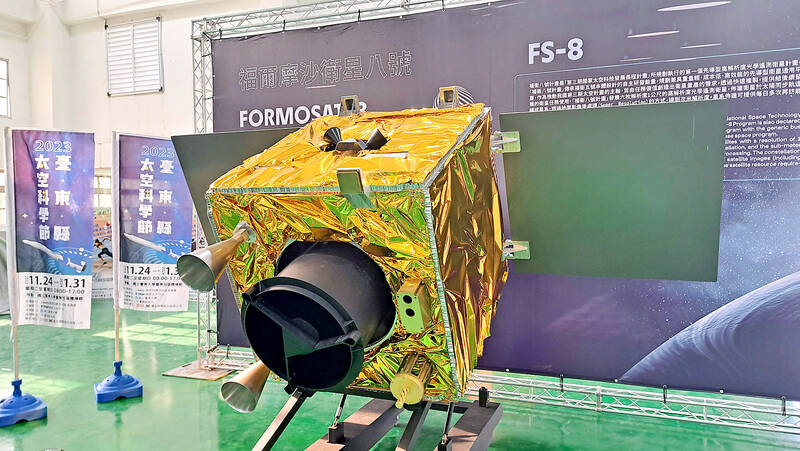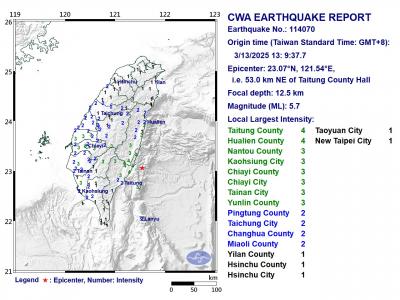The Formosat-8 satellite program would be equipped with eight Taiwan-made high-resolution optical remote sensing satellites and an artificial intelligence (AI) system, with one satellite launched annually over the next seven years, the Taiwan Space Agency (TASA) said.
In its draft of the third phase of the national space technology development project, which was submitted to the Executive Yuan at the end of last month, the National Science and Technology Council proposed to extend the project’s expiration date from 2028 to 2031, with the funding for the project expanding to NT$40 billion (US$1.2 billion).
The main tasks of the project would be to develop high-resolution optical remote sensing satellites and low Earth orbit satellites. The Formosat-8 is a pilot project for high-resolution optical remote sensing satellites, which would also be the nation’s first satellite equipped with an AI system.

Photo: Huang Ming-tang, Taipei Times
Based on TASA’s plan, Formosat-8, like Formosat-5, would be a light, low-cost, but highly efficient satellite platform designed and developed by Taiwanese engineers. Formosat-8 project manager Cynthia Liu (劉小菁) said the project would build a total of eight remote sensing satellites, with six of them having the ability to capture high-resolution images of objects 1m above ground from an altitude of about 561km.
“Post-processing” of the satellite images would show those of items 0.7m above ground, Liu said, adding that the resolution of the last two satellites would allow them to capture images under 1m above ground, she said.
The first remote sensing satellite — FS-8A — has completed a thermal vacuum test, Liu said, adding that it is scheduled to be launched into space in the fourth quarter of this year on a SpaceX rocket.
One satellite would be launched annually over the next seven years, she said.
The National Atomic Research Institute has also been researching the development of domestically produced solar cells, which are scheduled to be launched into space along with a second remote-sensing satellite in 2027.
If the solar cells are certified, the percentage of the satellite components made in Taiwan would be increased, Liu said.
“As countries around the world step up competition in the space age, solar panels that could be used in space are expected to be in high demand, she said.
“If we have the technology, we can develop the space industry further, and more countries would place orders for Taiwan-made solar cells,” she added.

CAUTION: Based on intelligence from the nation’s security agencies, MOFA has cautioned Taiwanese travelers about heightened safety risks in China-friendly countries The Ministry of Foreign Affairs (MOFA) yesterday urged Taiwanese to be aware of their safety when traveling abroad, especially in countries that are friendly to China. China in June last year issued 22 guidelines that allow its courts to try in absentia and sentence to death so-called “diehard” Taiwanese independence activists, even though Chinese courts have no jurisdiction in Taiwan. Late last month, a senior Chinese official gave closed-door instructions to state security units to implement the guidelines in countries friendly to China, a government memo and a senior Taiwan security official said, based on information gathered by Taiwan’s intelligence agency. The

The National Immigration Agency (NIA) said yesterday that it will revoke the dependent-based residence permit of a Chinese social media influencer who reportedly “openly advocated for [China’s] unification through military force” with Taiwan. The Chinese national, identified by her surname Liu (劉), will have her residence permit revoked in accordance with Article 14 of the “Measures for the permission of family- based residence, long-term residence and settlement of people from the Mainland Area in the Taiwan Area,” the NIA said in a news release. The agency explained it received reports that Liu made “unifying Taiwan through military force” statements on her online

Taiwan Semiconductor Manufacturing Co (TSMC), the world’s largest contract chipmaker, said yesterday that it is looking to hire 8,000 people this year, at a time when the tech giant is expanding production capacity to maintain its lead over competitors. To attract talent, TSMC would launch a large-scale recruitment campaign on campuses across Taiwan, where a newly recruited engineer with a master’s degree could expect to receive an average salary of NT$2.2 million (US$60,912), which is much higher than the 2023 national average of NT$709,000 for those in the same category, according to government statistics. TSMC, which accounted for more than 60 percent

A magnitude 5.7 earthquake struck off Taitung County at 1:09pm today, the Central Weather Administration (CWA) said. The hypocenter was 53km northeast of Taitung County Hall at a depth of 12.5km, CWA data showed. The intensity of the quake, which gauges the actual effect of a seismic event, measured 4 in Taitung County and Hualien County on Taiwan's seven-tier intensity scale, the data showed. The quake had an intensity of 3 in Nantou County, Chiayi County, Yunlin County, Kaohsiung and Tainan, the data showed. There were no immediate reports of damage following the quake.